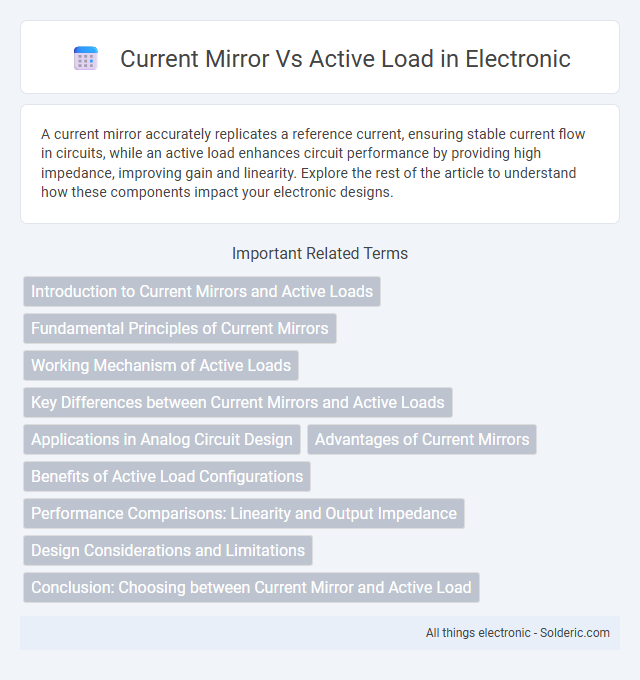A current mirror accurately replicates a reference current, ensuring stable current flow in circuits, while an active load enhances circuit performance by providing high impedance, improving gain and linearity. Explore the rest of the article to understand how these components impact your electronic designs.
Comparison Table
| Feature | Current Mirror | Active Load |
|---|---|---|
| Primary Function | Replicates current accurately | Improves gain by acting as a load |
| Application | Biasing, current copying in analog circuits | Amplifier stages for higher output resistance |
| Output Resistance | Moderate | High, boosting circuit gain |
| Simplicity | Simple design with fewer transistors | Complex; typically multiple transistors |
| Power Consumption | Low to moderate | Typically higher due to active devices |
| Voltage Headroom | Less critical | Requires sufficient headroom for operation |
| Usage in ICs | Widely used for accurate current referencing | Used for gain enhancement in analog ICs |
Introduction to Current Mirrors and Active Loads
Current mirrors replicate a reference current to provide stable biasing or amplification in analog circuits by maintaining a constant current regardless of voltage variations. Active loads use transistors configured to replace passive resistors, enhancing gain and linearity in amplifier stages through dynamic impedance control. Both structures are fundamental in integrated circuit design, optimizing performance in analog signal processing.
Fundamental Principles of Current Mirrors
Current mirrors operate based on matching transistor pairs to replicate a reference current with high accuracy, utilizing the transistor's base-emitter voltage characteristics for stable current replication. They rely on the principle of transistor saturation and the Early effect to maintain consistent current across varying loads, essential for analog circuit biasing and signal processing. Understanding these principles helps you design circuits with precise current control through active load configurations.
Working Mechanism of Active Loads
Active loads operate by using transistors configured to emulate high-impedance resistors, thereby enhancing gain and linearity in amplifier circuits. Unlike current mirrors that primarily replicate current, active loads control the voltage drop across devices to maximize output voltage swing and improve performance. Your circuit benefits from active loads through increased efficiency and precision in current steering, enabling better signal amplification and reduced distortion.
Key Differences between Current Mirrors and Active Loads
Current mirrors replicate reference currents with high accuracy to provide stable biasing in analog circuits, while active loads function as controlled impedance elements that enhance gain by improving output resistance. Current mirrors primarily focus on current copying for precise current biasing, whereas active loads optimize voltage gain and linearity in amplifier stages. Design trade-offs include complexity and power consumption for current mirrors versus performance benefits and voltage headroom in active loads.
Applications in Analog Circuit Design
Current mirrors provide precise current replication crucial for biasing analog circuits, ensuring stable operation in amplifiers and ADCs. Active loads enhance gain and output resistance in amplifier stages, optimizing linearity and frequency response in operational amplifiers and analog multipliers. Both techniques are fundamental in low-power design and integrated circuit fabrication, improving performance in signal processing and sensor interfaces.
Advantages of Current Mirrors
Current mirrors offer precise current replication with high output impedance, enabling improved circuit stability and biasing accuracy in analog designs. They provide better matching, which reduces voltage variations and enhances linearity compared to simple active loads. Their ability to maintain constant current regardless of load changes makes them ideal for integrated circuit applications requiring consistent performance.
Benefits of Active Load Configurations
Active load configurations offer superior linearity and higher output impedance compared to current mirrors, enhancing gain in analog circuits such as operational amplifiers. These loads improve voltage swing and frequency response by minimizing voltage drops and parasitic capacitances. Their ability to maintain stable current under varying voltage conditions results in improved overall circuit performance and efficiency.
Performance Comparisons: Linearity and Output Impedance
Current mirrors offer moderate linearity with output impedance typically in the range of a few hundred kilohms, making them suitable for general current replication tasks. Active loads enhance linearity significantly and provide much higher output impedance, often reaching several megaohms, improving voltage gain and signal fidelity in amplifier circuits. The superior output impedance and linear response of active loads result in better performance for high-precision analog designs compared to basic current mirrors.
Design Considerations and Limitations
Current mirrors require precise transistor matching to ensure accurate current replication, with performance limited by channel-length modulation and output resistance. Active loads provide higher gain and improved linearity in amplifier stages but introduce increased design complexity and potential stability issues due to parasitic capacitances. Both structures demand careful biasing and layout to minimize mismatch, noise, and variations caused by temperature and process fluctuations.
Conclusion: Choosing between Current Mirror and Active Load
Choosing between a current mirror and an active load depends on your circuit requirements for accuracy, output impedance, and power efficiency. A current mirror offers precise current replication ideal for biasing and reference circuits, while an active load provides higher output impedance and improved gain in amplifier stages. Your design constraints and performance goals determine which component best suits your application.
Current mirror vs Active load Infographic

 solderic.com
solderic.com